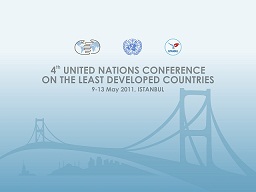UN Conference on the Least Developed Countries in İstanbul, Turkey

The 4th since 1971, Part I.
Below and attached is Part I of a Commentary on the UN Conference that began in Istanbul today. There is so much to report but not enough time, especially chance encounters with representatives from some of the LDCs, such as from Mozambique and Yemen, who told me that Istanbul is the most
beautiful city that he has seen in his life. More to follow.
by
Yuksel OKTAY
Representative of The Light Millennium
[İstanbul, 9 May 2011] The week long Conference on the Least Developed Countries (LDCs), the 4th in 40 years, began at the Lutfi Kırdar, İstanbul, the Military and the Hilton Conference and Exhibition Centers combined, with the attendance of over 10,000 delegates from 48 LDCs, donor and member countries from around the world. This must be the biggest conference held in Turkey to date with 29 Heads of State, 20 Prime Ministers, 90 Ministers, 50 NGOs and many other high level participants from around the world. An exhibition of close to 150 stands by the LDC countries and various organizations is also being held at the İstanbul Congress Center.
The Fourth conference has been organized by the United Nations and TUSCON, the Turkish Businessman Confederation, which has held many conferences, including many in Africa, since its founding in 2005.
The Conference has been arranged in five separate tracks:
Intergovernmental Track.
Parliamentarian Track
Civil Society Track
Private Sector Track
The Intellectuals’ Track at Bogazici University
The Conference is intended to review the implementation of the expiring Brussels’ Programme of Action and adopt İstanbul Program of Action for the 2011-2021 decade. The group of world’s poorest countries first gathered in 1981 in Paris, hosted by France, including the second conference in 1991.
The third conference was held in 2001 in Brussels, on behalf of the European Union. During the Civil Society Forum held on Sunday, May 8, the Secretary General highlighted the significance of İstanbul summit on LDCs while some commentators stated that Turkey appears to be promoting an agenda that may not exactly coincide with what the previous hosts had in mind. Turkey, one of the donor countries and considered a bridge between East and West, now aspires to bridge differences between the rich North and the poorer South, perhaps offering an answer as to why these countries are poor and how they can be helped to becoming developed nations.
The opening speeches were made by Turkish President Abdullah Gul, Prime Minister Recep Tayip Erdogan and the UN Secretary General Ban Ki-moon. Referring to the increase in the number of LDCs from 25, when the first conference was held, to 48 at present, Secretary General called on all countries to keep their promises to offer assistance and asked for the support of the civil societies. Turkish Prime Minister complained that the
countries had not kept their promises from the earlier conferences. Also, referring to the terrorism around the world, the Prime Minister stated that many countries withheld their support for Turkey’s fight against its own PKK terrorism and some countries even helped the terrorist organization
The program and several publications among the many distributed at the conference listed a total of 48 LDCs, 1 country, Haiti in Latin America, 14 in Asia and 33 in Sub-Saharan Africa out of 192 member states of the United Nations. (1). Total population of 48 countries is reported to be over 950 million out of close to 7 billion-world populations...
Among the NGOs from around the world, including Doctors Worldwide, there were several from Turkey as well, including Deniz Feneri, Yardımeli Dernegi, Insan Hakları ve Mazlumlar icin Dayanısma Dernegi, (Provided copies of 2010 Turkistan Human Rights Report), IHH Insani Yardım Vakfı (Provided copies of the UN Report on Mavi Marmara), Ilkder, Genc Gonulluler, İstanbul Chamber of Commerce, Turkiye Barolar ve Borsalar Birligi, TIKA and others. Todays Zaman newspaper distributed a 96 page supplement on the Conference.
The programme lists over 200 presentations on various aspects of development, investments and cooperation among the countries. There were also sign-up lists for one-on-one meetings, including discussions for the development of power projects. It would have been fitting to include a presentation on how Turkey became a developing country and the 16th largest economy in the world when the Republic was one of the LDC in 1923.
What and how Mustafa Kemal Ataturk and his comrades accomplished the transformation from a feudal state into a modern state in just 15 years bringing it to the Take-Off stage in 1935, as stated by Prof Rstow (1).
Large posters of Ataturk at the Conference Centers, as displayed in the Hilton lobby, would have also been fitting to honor one of the greatest leaders of the 20th century.
Yuksel Oktay, Representative
The
Light Millennium
Istanbul, May 9, 2011
Notes.
(1). The LDCs include: Haiti from Latin America, Afghanistan, Bangladesh, Bhutan, Cambodia, Kiribati, Lao People’s Democratic Republic, Myanmar, Nepal, Samao, Salomon Islands, Timor-Leste, Tuvalu, Vanuatu and Yemen from Asia, Benin, Burkina Faso, Burundi, Central African republic, Chad, Comoros, Democratic Republic of Congo, Djibouti, Equatorial Guinea, Eritrea, Ethiopia, Gambia, Guinea, Guinea-Bissau, Lesotho, Liberia,
Madagascar, Malawi, Mali, Mauritania, Mozambique, Niger, Rwanda, Sao Tome and Principe, Senegal, Sierra Leone, Somalia, Sudan, Togo, Uganda, United republic of Tanzania, Zambia from Africa.